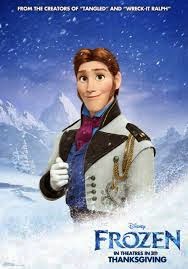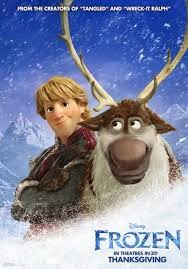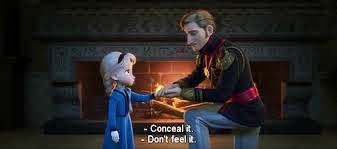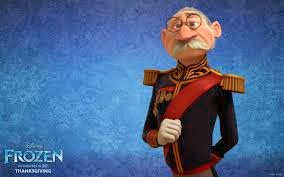Expendable Men and Modern Women in Frozen
So I have finally got around
to viewing Disney’s 2013 animation Frozen
(Chris Buck and Jennifer Lee, 2013). Let me say up front that it took me
two attempts to get through the film, because I am, for the most part, not a fan
of musicals. Also be aware that in the pursuit of an informed critique of gender and feminism, this
film review contains numerous spoilers.
Frozen transforms
Hans Christian Anderson’s classic fairy tale about a villainous The Ice Queen, into a nuanced account of
how social prejudice drives desperate people to commit (what are perceived to
be) harmful or immoral acts. The film begins with an unfortunate childhood incident
when Princess Elsa accidently harms her little sister Princess Anna, when she
misdirects her magical power to conjure up ice and snow. This sets the scene
for Elsa’s isolation and her life-long quest to suppress the emotions that regularly
set off her strengthening powers. Fast-forward a number of years, the girls
have come of age, their parents have died and the coronation of Elsa as Queen
is immanent. At the coronation emotional turmoil leads to the public exposure
of Elsa’s powers, which in turn catalyses a series of events including her
self-imposed exile in the wilderness, the onset of an eternal winter, and
Anna’s desperate attempts to reconnect with her sister and undo the environmental
disaster.
What I want to zero in on
here is the very interesting subversion of normative gender roles by Disney, whose
fairy tale adaptations have historically emptied original narratives of their
sophisticated accounts, of young girls negotiating a moral minefield to emerge
experienced and worthy women. Within the Disney canon, feminine agency has
largely been the province of the bitter and twisted villainess; the good girl
is distinguished by her willingness to wait patiently for a strange prince to
rescue her from the maws of certain doom (think Snow White, Sleeping Beauty and Cinderella).
But wait you say, the 1990s
ushered in a period of Disney animation characterised by feisty princesses
whose adventurous spirit could not be tamed (Belle in Beauty and the Beast, and Ariel of The Little Mermaid come to mind). While this may be so, the
narratives of these films are still characterised by the motif of romantic love,
and impossible stereotypes of idealised, chivalrous men. Narrative resolution only
occurs in these films when the princess secures a relationship with the prince
of her dreams.
What I want to suggest is
that far from a straightforward subversion of harmful gender stereotypes and
narrative motifs, Frozen actually
propagates a slate of contemporary ones that are quite reflective of the kinds
of gender inequality that exist today.
At the outset I would like
to acknowledge the fantastic plot twist whereby the act of true love needed to
save Anna, ostensibly the films principle heroine was not a kiss from her
prince but rather an act of self-sacrifice to save her sister. The film
explicitly flags this resolution as act of narrative subversion much earlier in
the film. Anna, having been accidentally wounded by Elsa during an ill-fated attempt
to reconcile, seeks the kiss of her true love Hans to save her from certain
death. As Hans slowly leans in to kiss the ailing Anna, he pauses, pulls back
and reveals that he cannot save her because he does not love her. Indeed, he has
deceived Anna into loving him so as to become king. After this startling
revelation, he promptly leaves Anna for dead.
It is Hans’ cold
manipulation of the hapless Anna that foregrounds my key problem with the film;
that is, the replacement of negative female stereotypes with negative male
stereotypes. Let’s take a closer look at our four key male characters.
King, father of Elsa and Anna
Once informed that Elsa’s
powers will grow and could be potentially detrimental to the kingdom, the King
effectively imprisons his young daughter. She is denied supportive
relationships and taught to bury her emotions so that they will not negatively impact
upon others. His failure to seek guidance and mentorship to help Elsa through
this difficult phase of childhood development is ultimately neglectful, yet the
film does not really draw attention to him as a harmful figure in Elsa’s life.
He is merely a plot device to catalyse the narrative, a stopgap that once removed,
unleashes terrible misfortune upon his kingdom.
The Duke, the evil capitalist
The Duke is another one-dimensional
character that largely serves the function of red herring, prompting audiences
to assume that he is the villain of the piece. This tiny leader of Weasel town
is clearly only interested in exploiting trade relations with the kingdom for
its own profit. He is in this sense, an embodiment of what feminists like to refer
to as patriarchy, embodied in the image of middle-aged white men who govern the
economy for their own benefit, and to the detriment of unsuspecting and
benevolent women. The physical rendering of this character, combined with his
capitalistic motivations, certainly embodies this villainous image of
patriarchy.
Hans, the upwardly mobile Prince of the Isles
Early in the film Hans is
the embodiment of the noble prince desired by princesses everywhere. He is
however another fairly under developed character allowing for the plot twist
exposing his conniving, self-interested and heartless character. This is not in
itself a problem, every Hollywood plot needs a villain to keep the drama
rolling, and as stated above, Hans is key to blowing apart the myth of romantic
love and unrealistic expectations of masculinity. Hans however, also serves to
round out a stable of negative male characters that tell us that: man + power = evil.
 |
| Prince Hans |
 |
| Kristoff |
Kristoff, the disposable male
With Kristoff we come to the
hero of the piece. Kristoff is humble and hardworking member of the working
poor. This is clearly indicated in a sequence when he unsuccessfully haggles for
basic supplies. His massive and muscly stature implies that he must engage in
difficult manual labour to earn the pittance that he lives off, this is also
indicated in the opening sequence representing the hard labour required to
harvest blocks of ice, Kristoff’s stock in trade.
Kristoff’s benevolent
humility is reiterated via his interactions with Anna, whereby he regularly assumes
his proper place below Anna in the social hierarchy (as both male and working
class). For instance, when Anna prematurely rushes to scale the mountain,
Kristoff who is more knowledgeable about achieving such a task, hangs back and
waits for her to realise that she needs his help. This reminds me very much of old
US family sitcoms where the obedient wife, who the audience recognises as more
knowledgeable than the domineering husband, waits for him to come around so
that she can dispense her expertise in an unassuming and non-threatening manner.
Most pertinent however, is
that Kristoff very much conforms to what Karen Straughan has termed “the
disposable male.” An evolutionary psychologist, Straughan posits that men have
predominantly come to be valued in society only insofar as they are willing and
able to sacrifice themselves for the benefit of women and society. Kristoff
regularly engages in acts of self sacrifice, for instance, when he sacrifices
his own happiness and delivers Anna back to her “true love” Hans to be healed,
and also, when he places himself in danger and helps her track down Elsa.
Sacrifice, as a
demonstration of male worth, is one of those under-acknowledged phenomenon’s
that abound in everyday life. Think for instance of celebrations and memorials
for war heros who have sacrificed themselves for the good of the nation-State.
Think also of the fact that it is men who are expected to assume more difficult
and strenuous forms of manual labour, detrimental to their long-term physical
health. That men have come to fulfil these roles is largely a part of human
evolution; humans are dimorphic, and men are for the most part, the naturally
stronger gender.
However, in contemporary
Western cultures, where it is assumed that democratic freedoms have liberated
humans from the shackles of biology and enabled everyone to craft their own
destiny, men - like women, the disabled, homosexual, transgender, black ethic
and other minority peoples – are in actuality, limited by enduring economic
constraints and social prejudices.
Contemporary understandings
of gender inequality, largely influenced by decades of feminist activism, tend
to obscure the ways in which many men are also constrained by social norms.
Think, for example, of campaigns calling for economic inequality that focus on
women’s access to corporate leadership roles rather than the ability to work
side-by-side with men in sewerage treatment plants or on the military frontline.
That Kristoff is the only positive
(human) male character in Frozen contributes to the widespread misapprehension
that the only good men in society are those that are willing to sacrifice their
lives and wellbeing for the common good.
This I think is the key
problem with Frozen. In line with
current social trends, the film’s attempt at gender subversion is mired in the
misconception that women are singularly disadvantaged by cultural
representations. The lack of critical attention to forms of gender inequality
that also effect men just creates a situation in which the pendulum swings the
other way, and women become blind to the specific ways in which they are privileged by
their gender. And this is detrimental to BOTH men and women. What will girls
gain from unrealistic perceptions of men as subservient, expendable or evil?
Like the trope of prince charming and true love dispelled by Frozen, these misconceptions of masculinity
do not inform the pursuit of meaningful and equal relationships, but rather,
continue to fuel unrealistic expectations of men.





Comments
Post a Comment